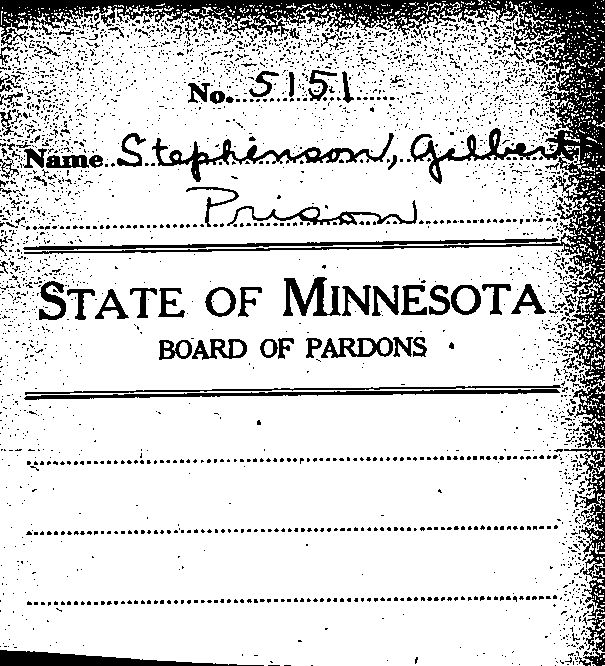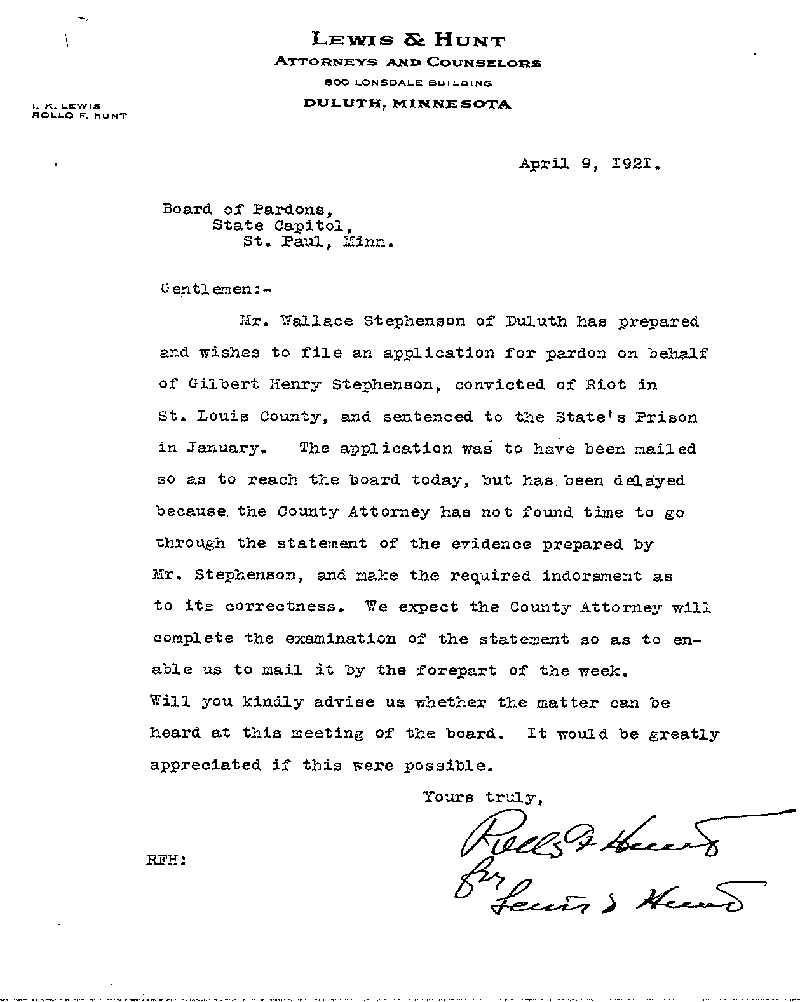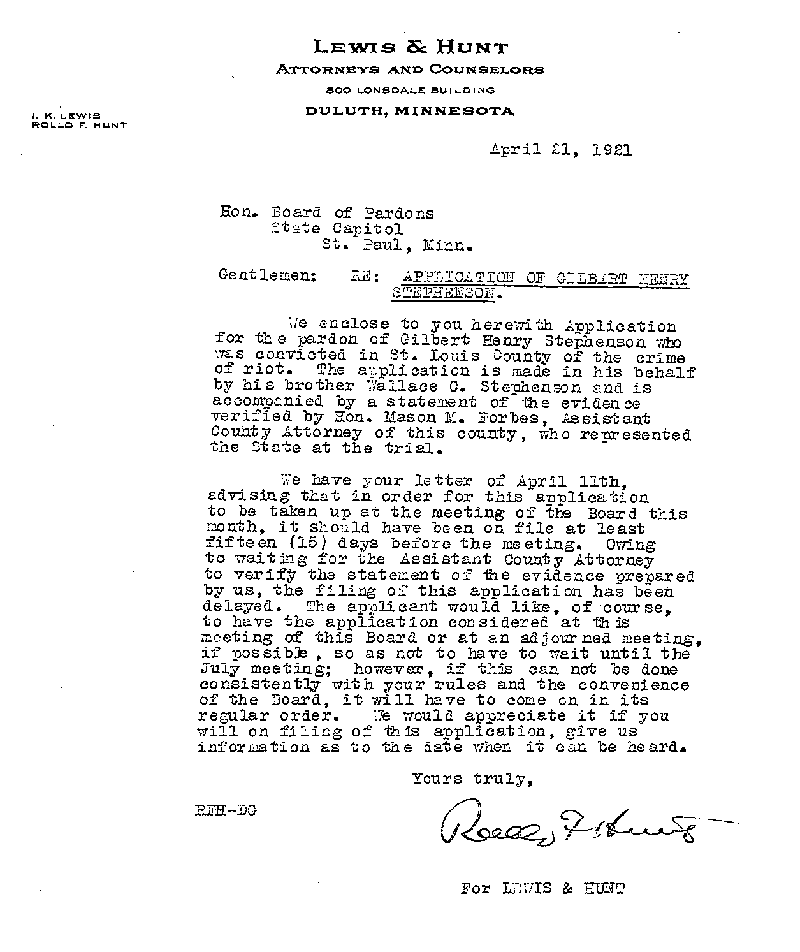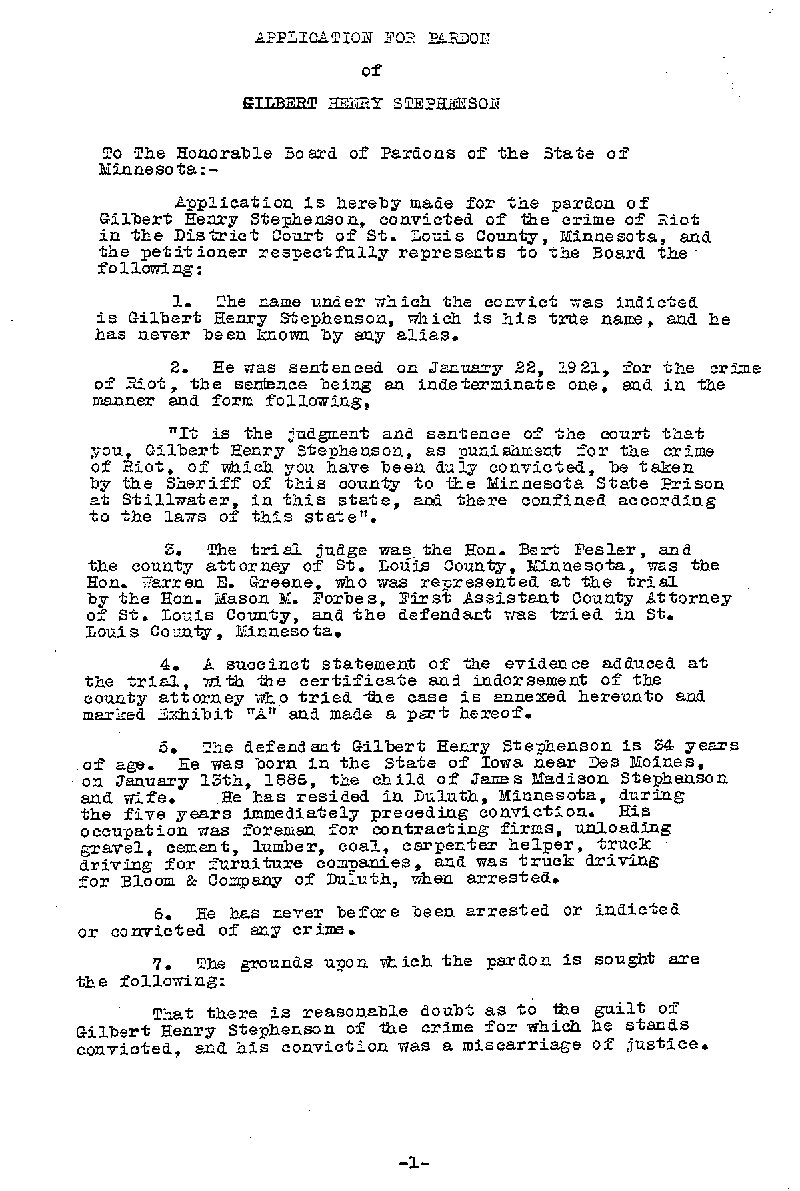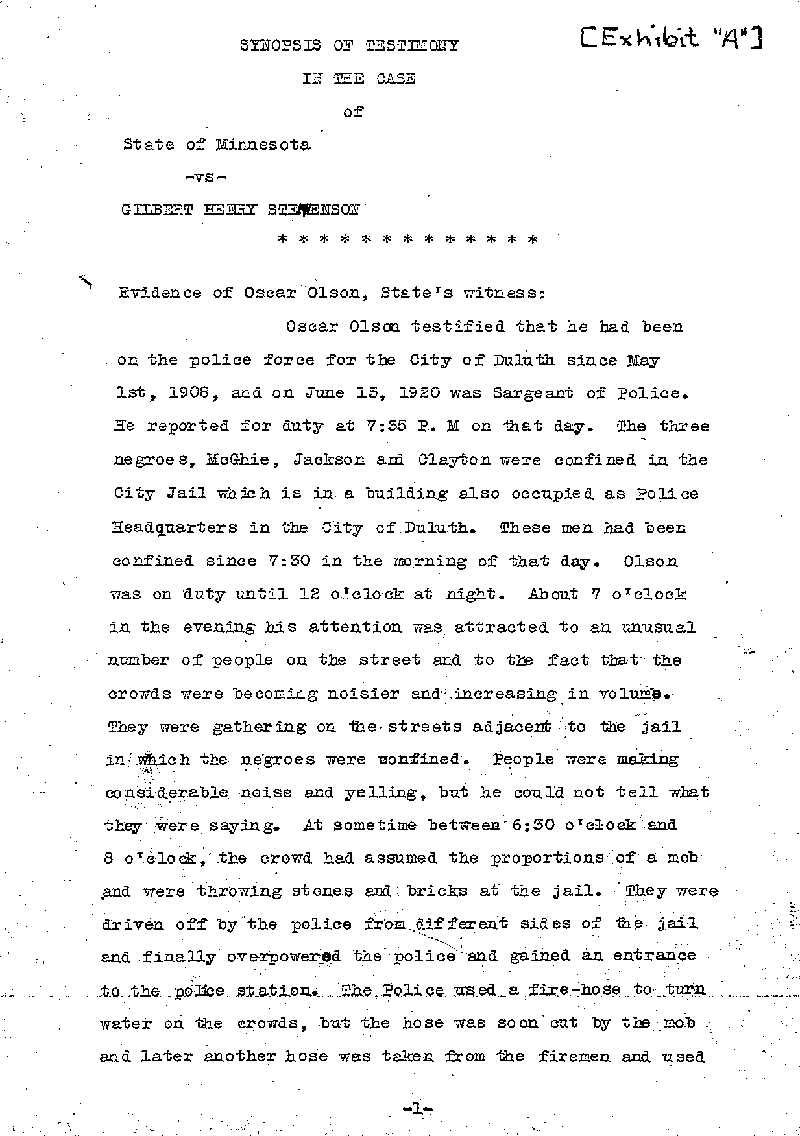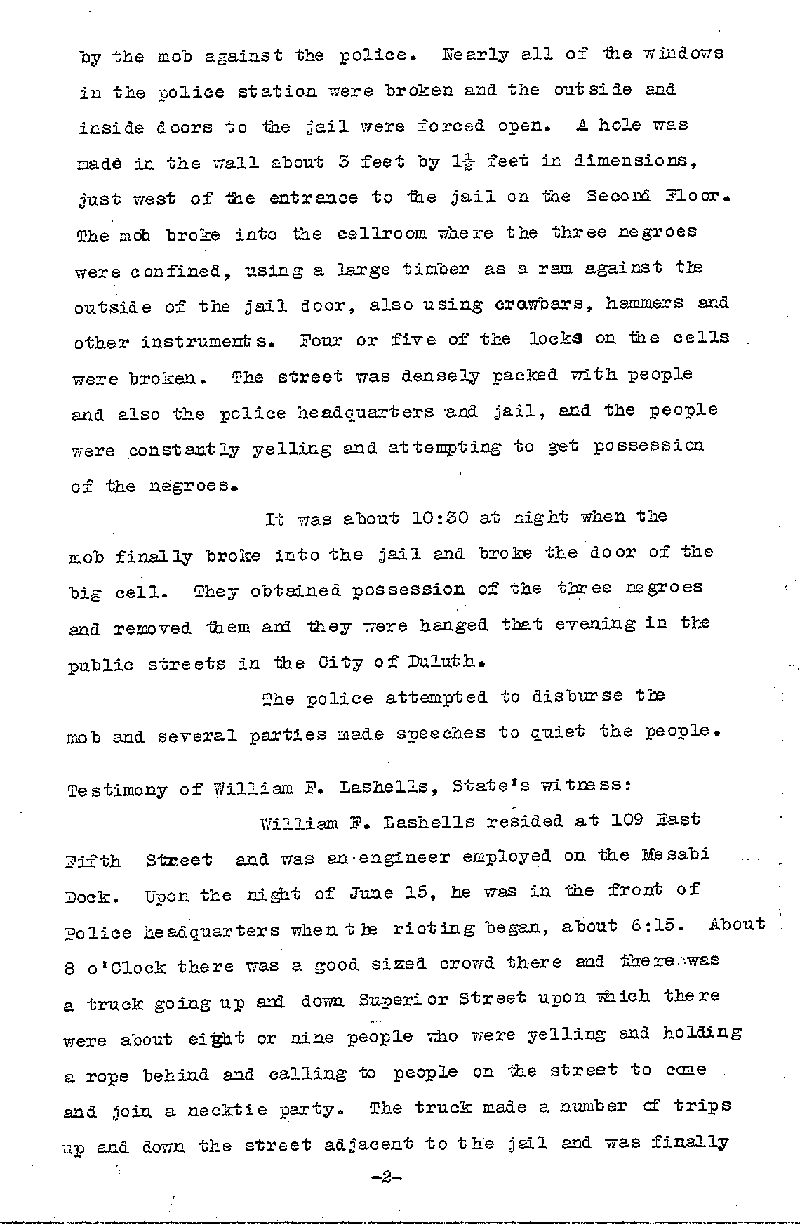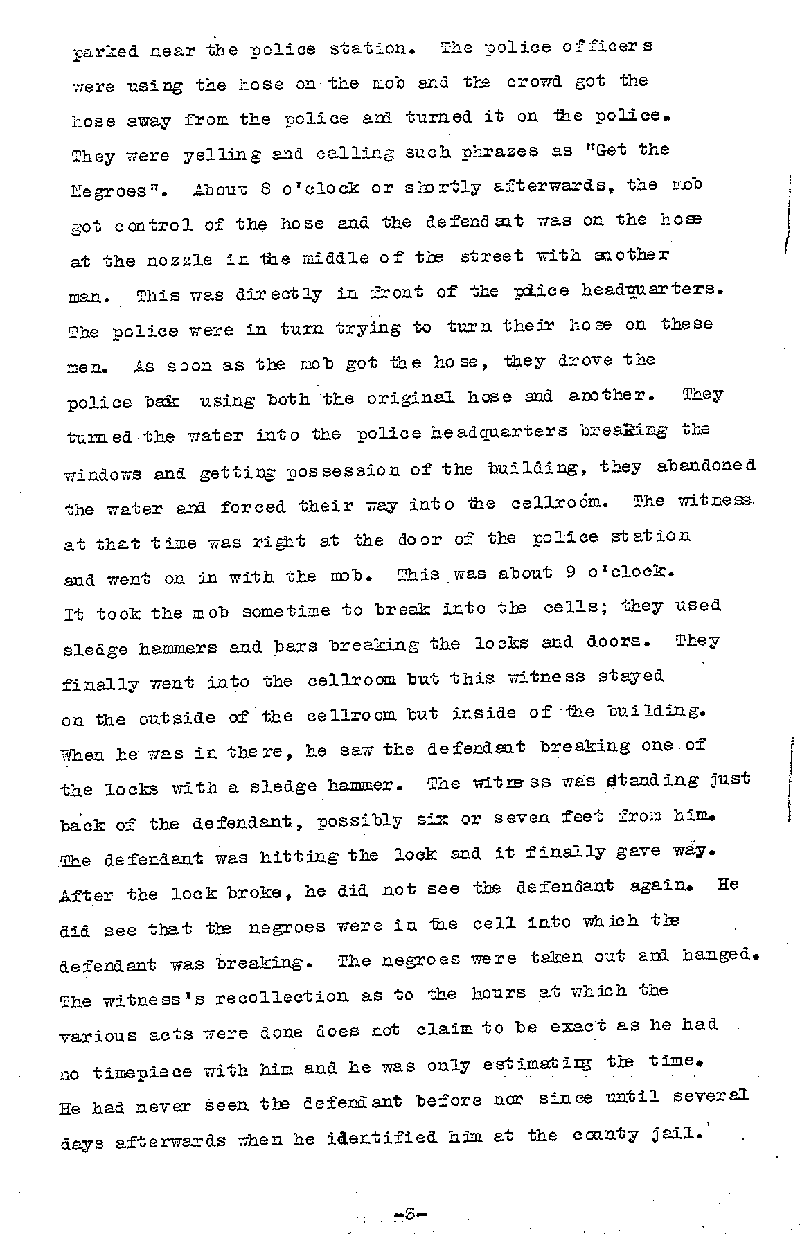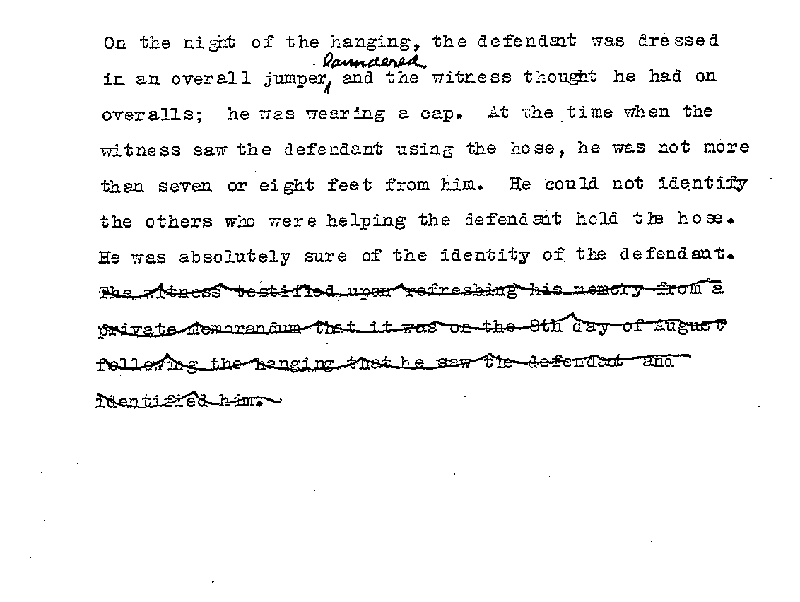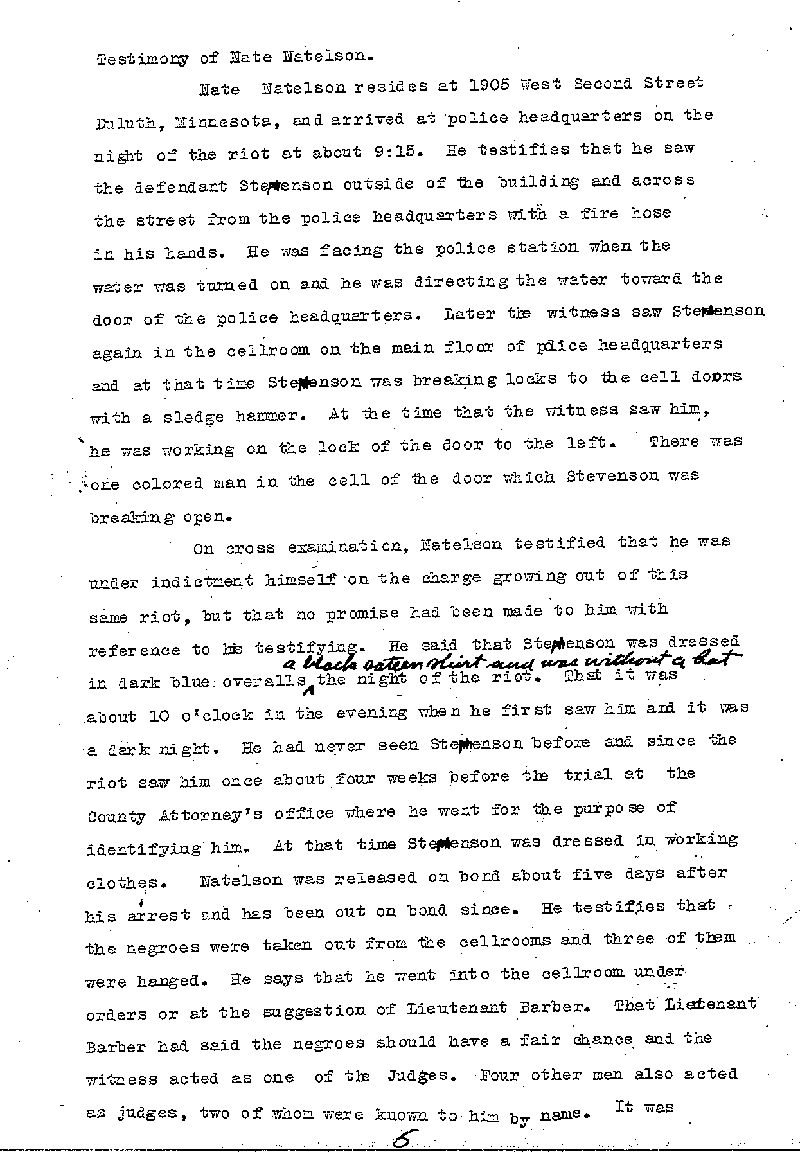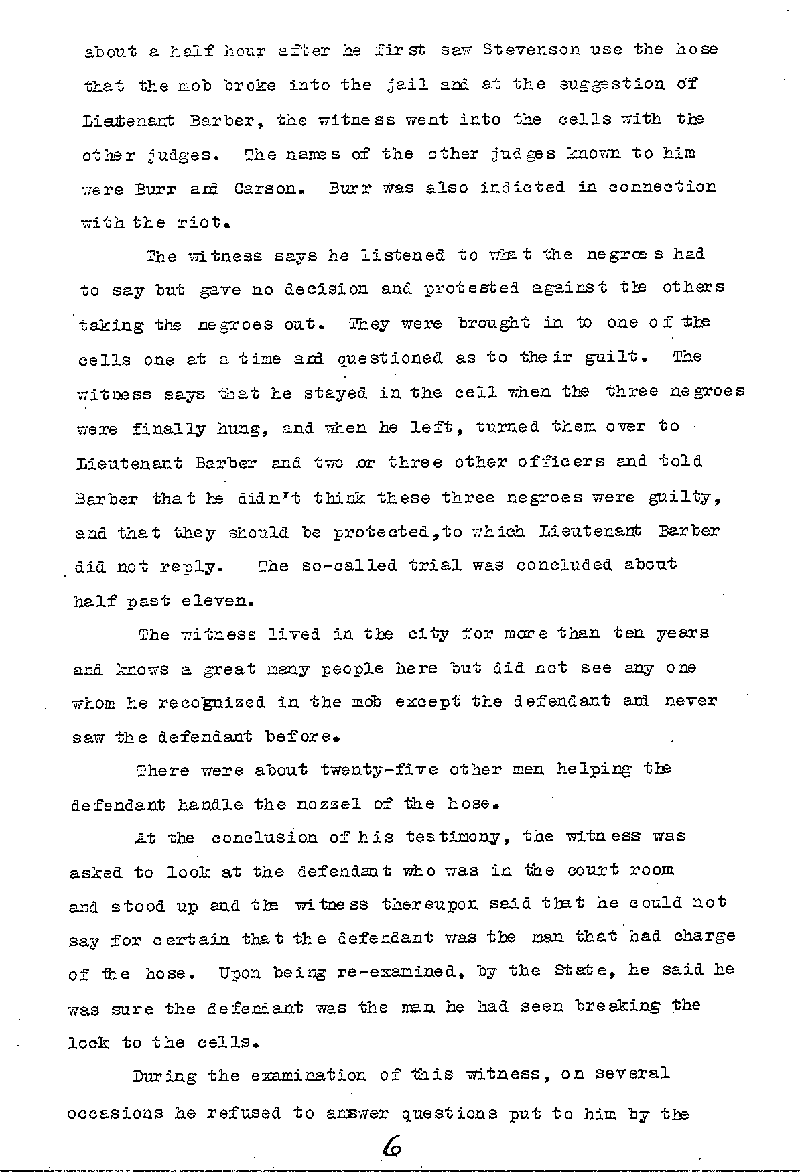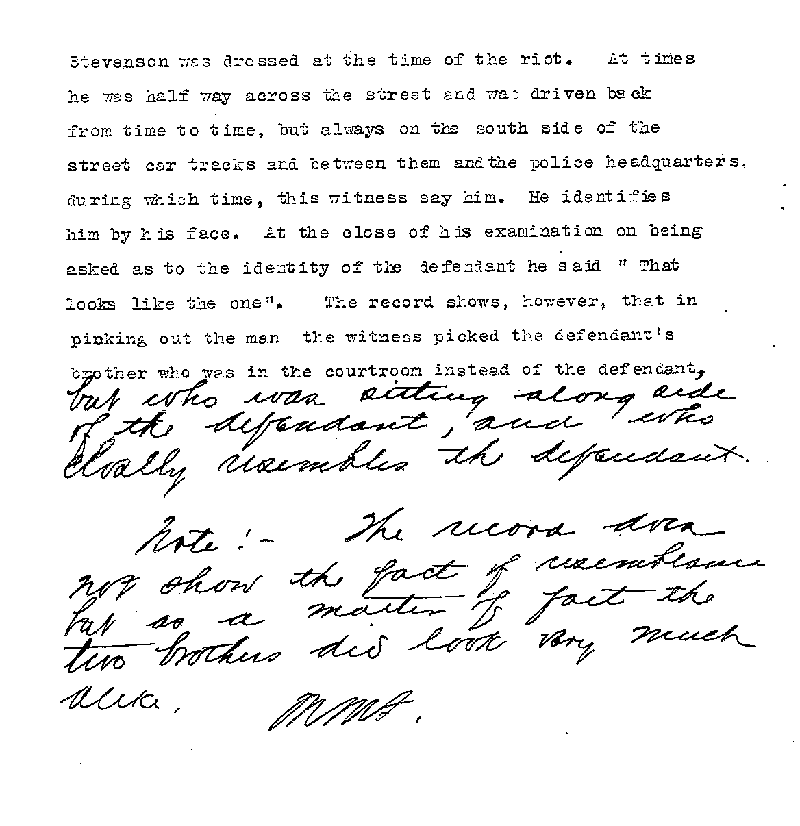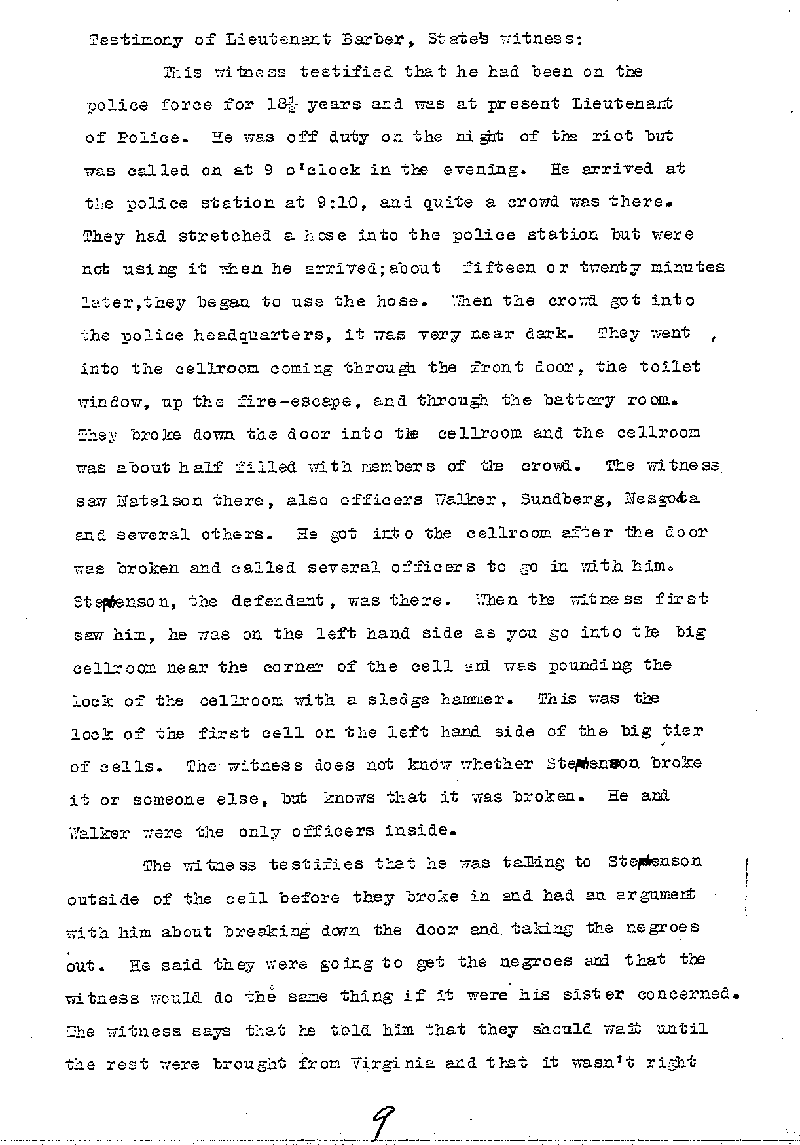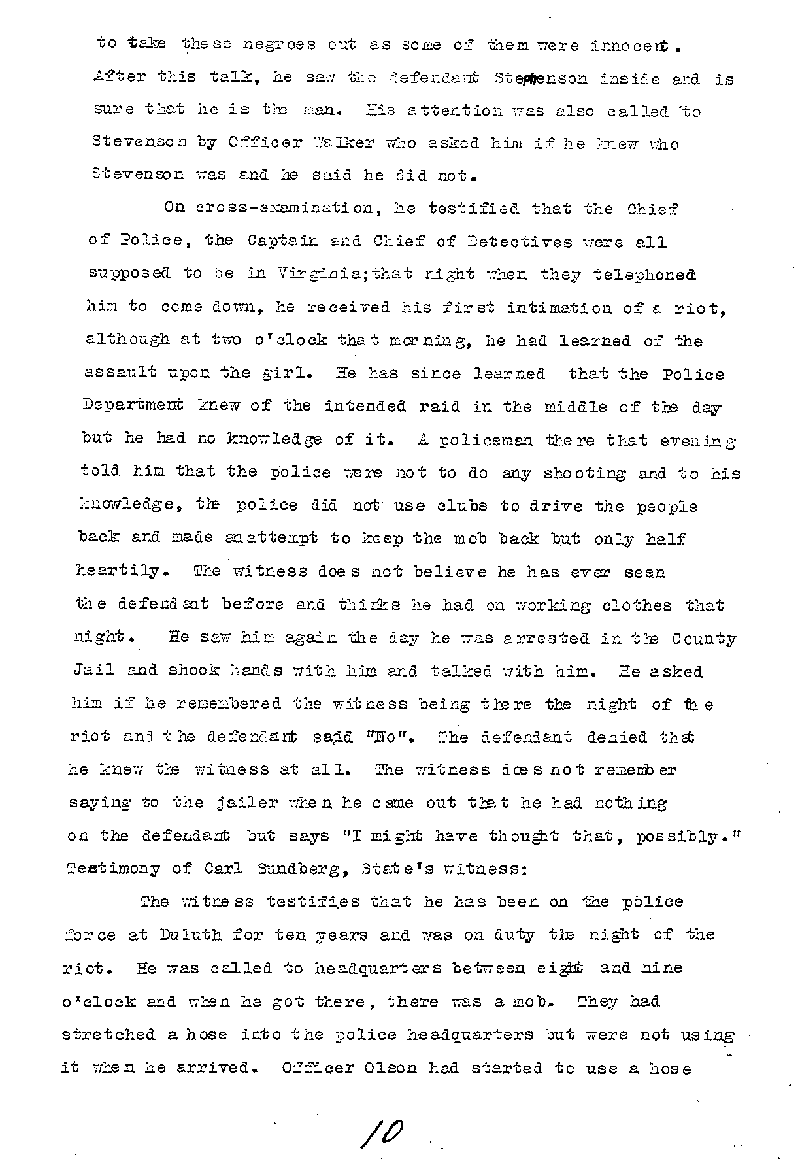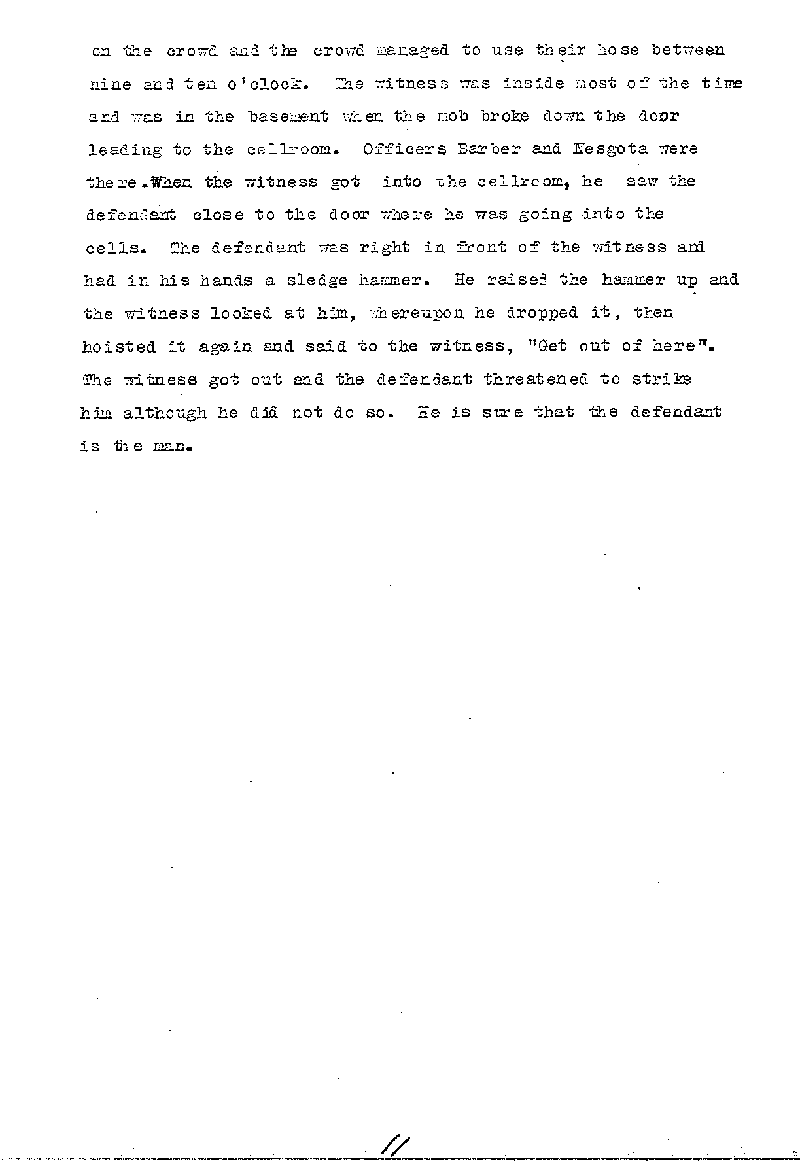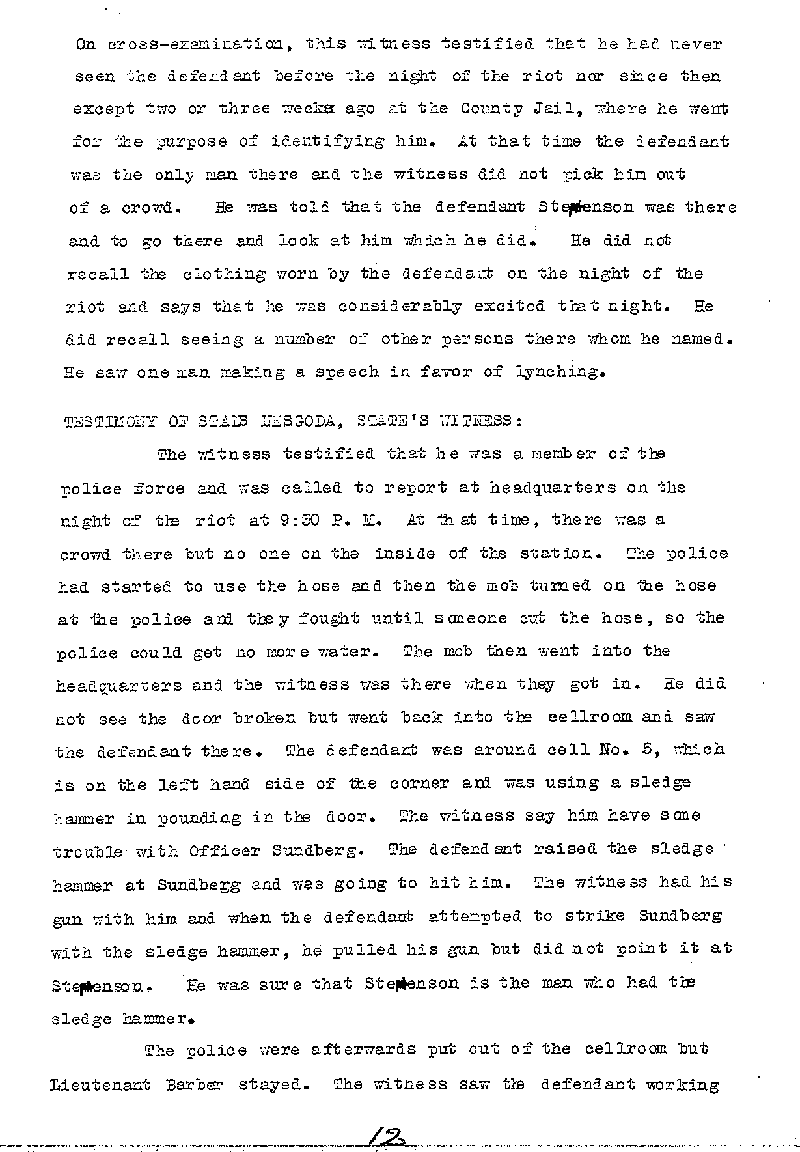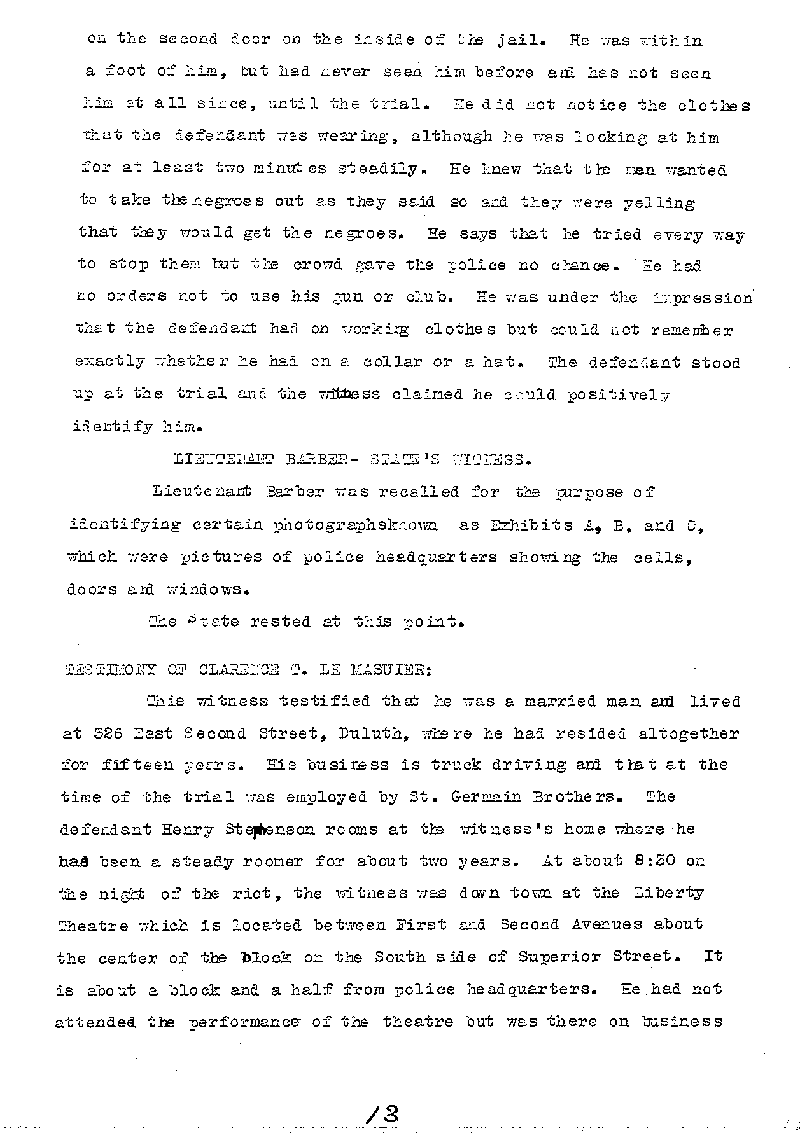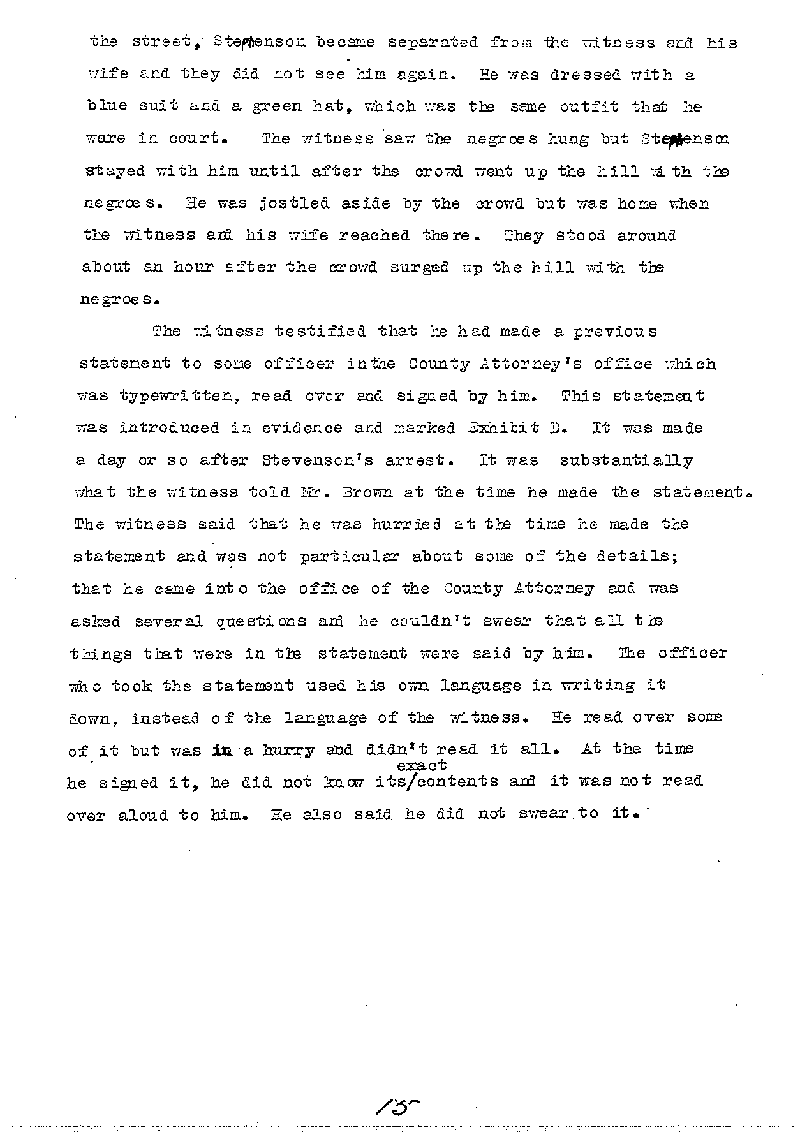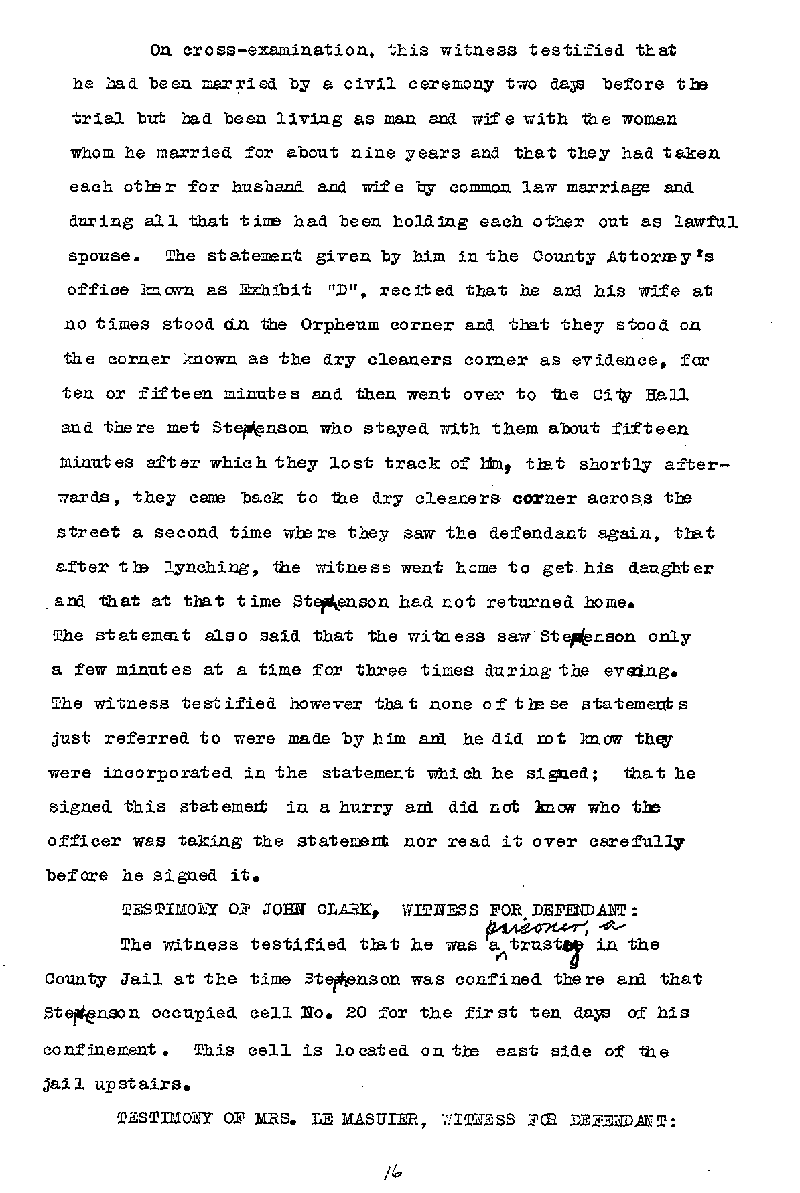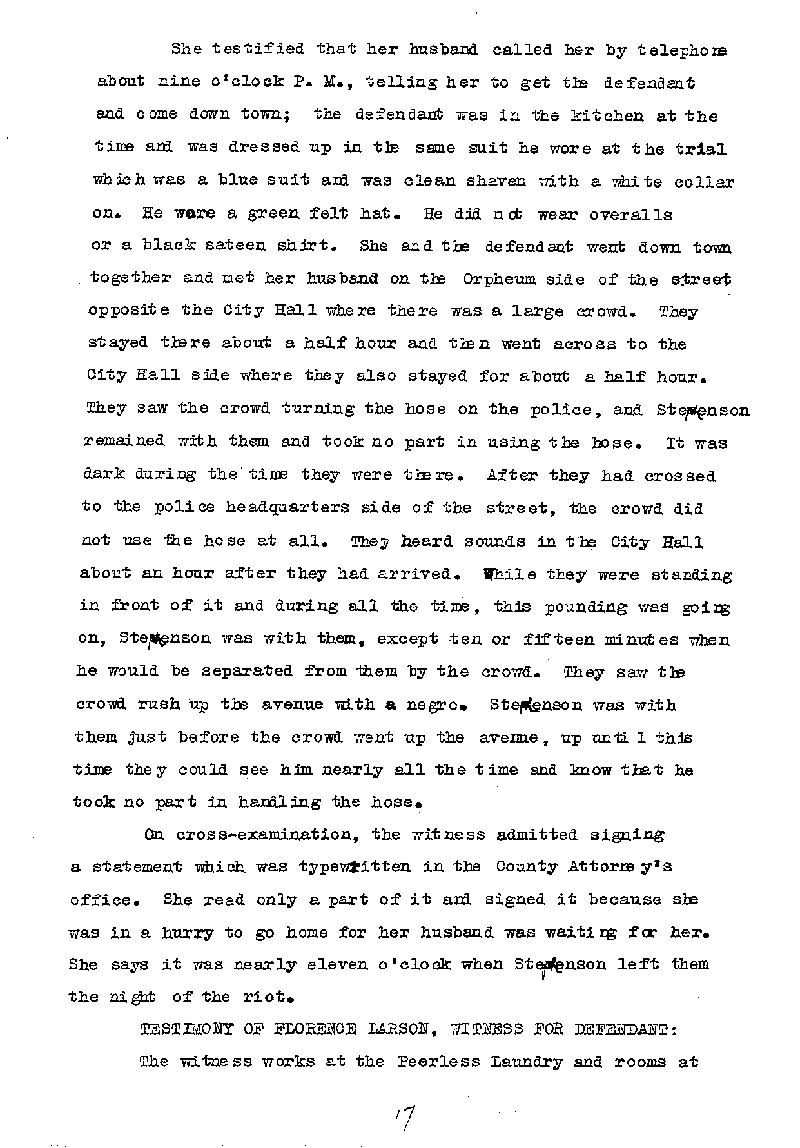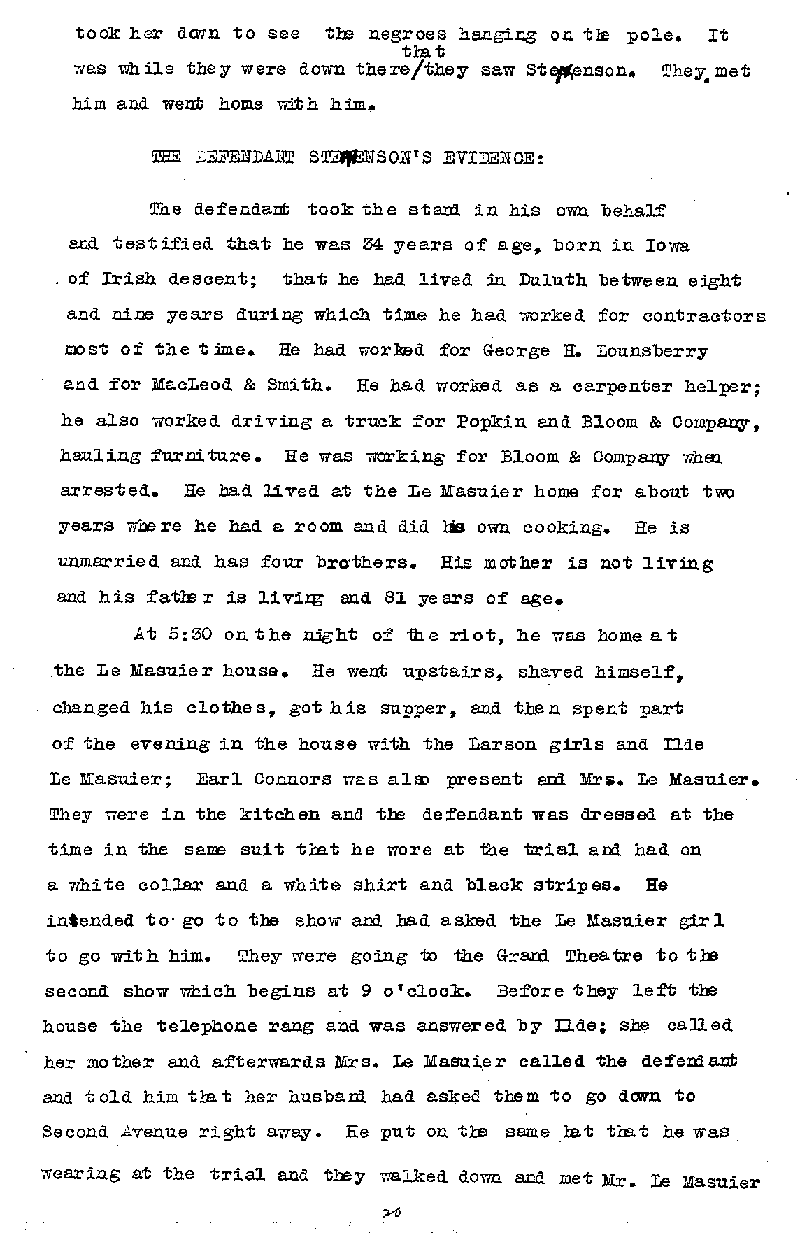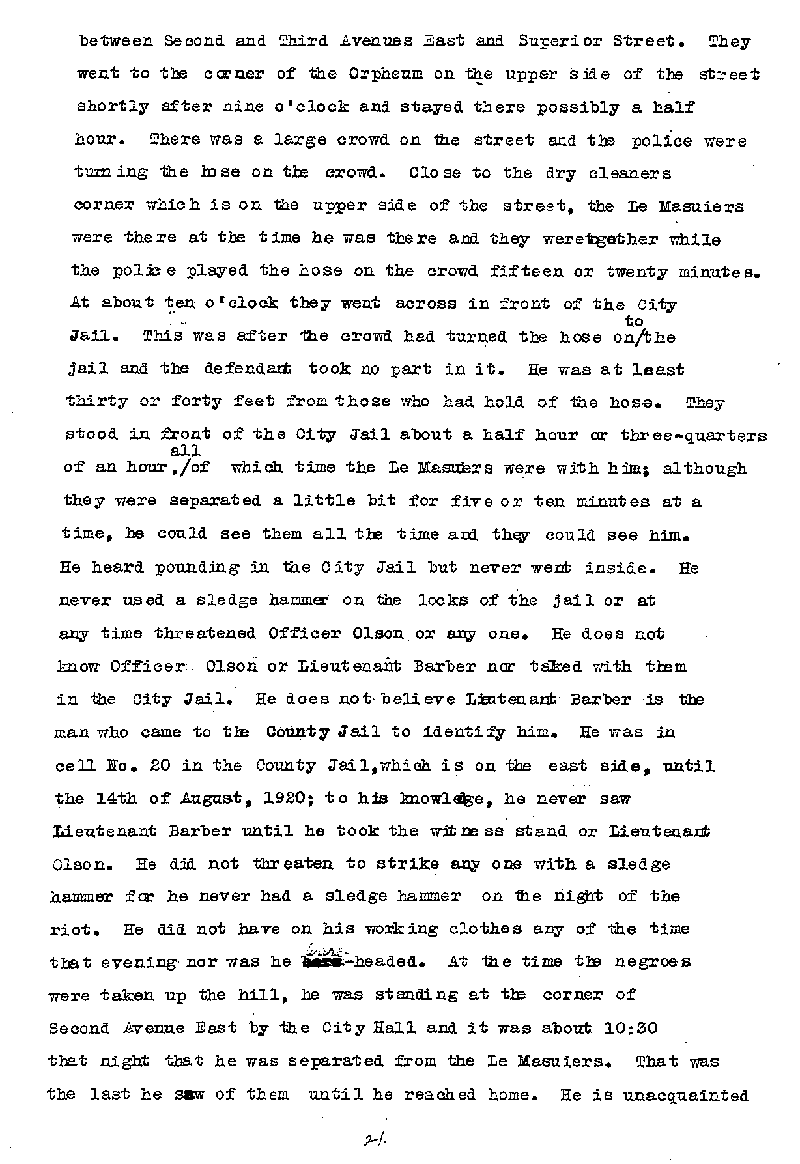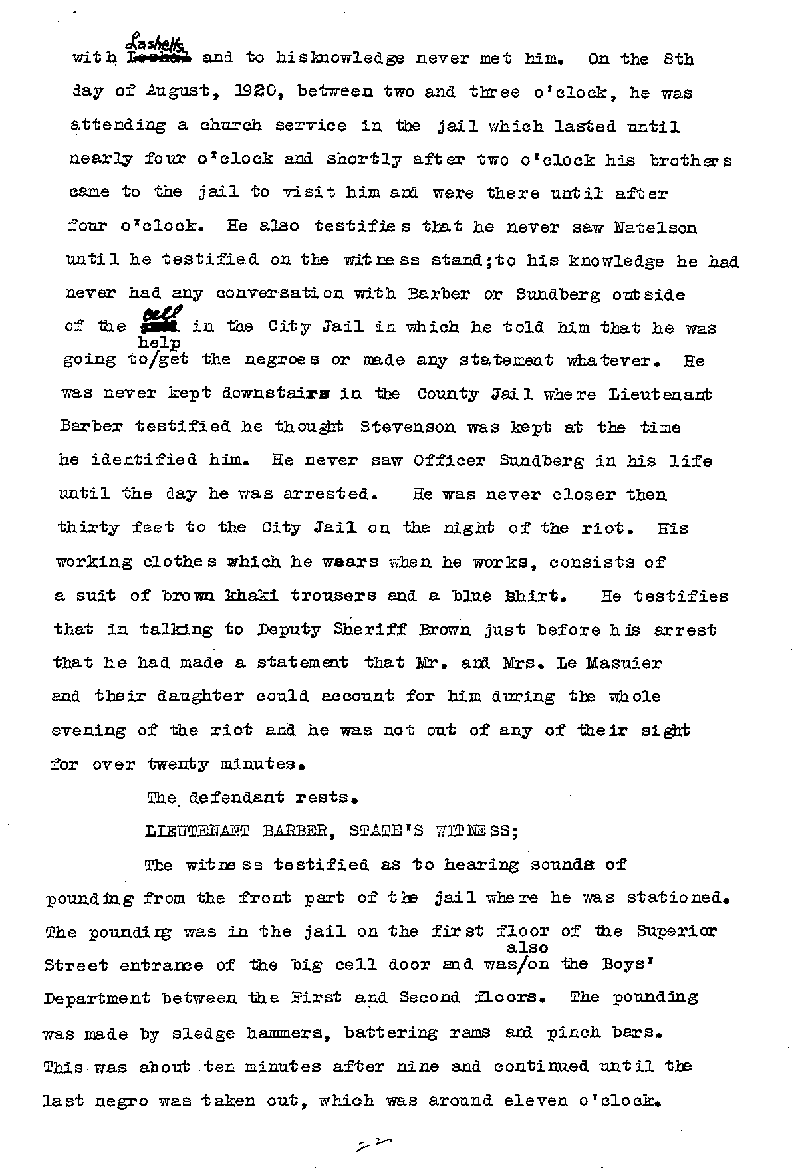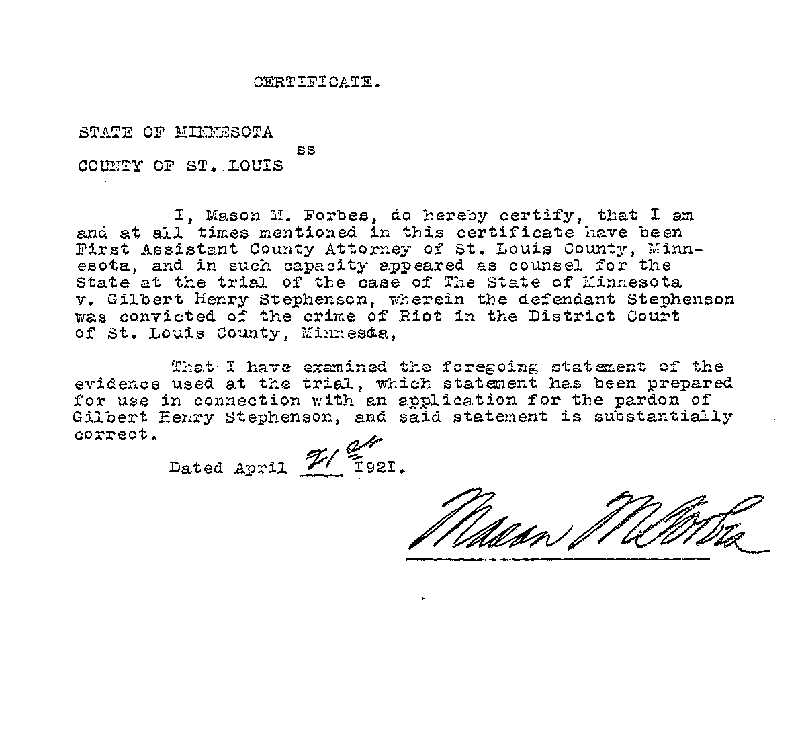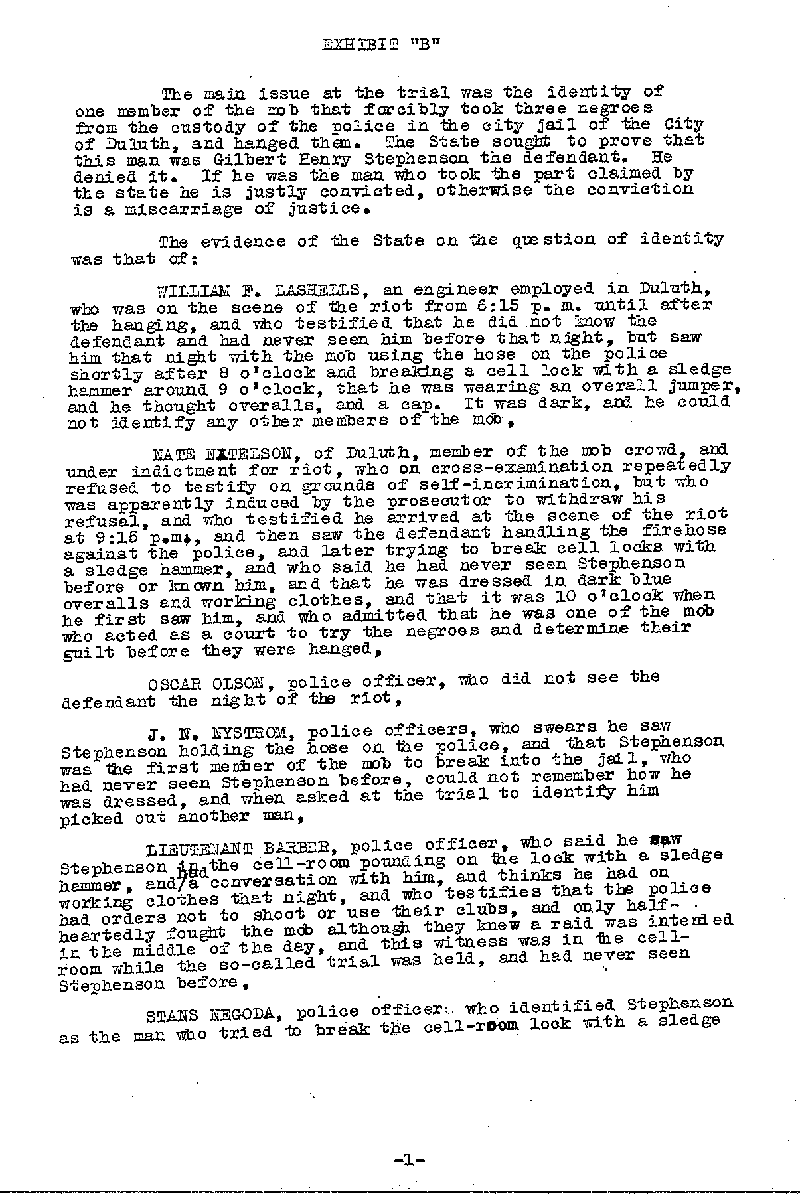Gilbert Henry Stephenson. Application No. 5151, 1921.
Type of event: Incarcerations
Location: Minnesota; United States
Document date:
Document type: Gov't Record(s)
Document subtype: Pardon Application
Documents: Gilbert Henry Stephenson. Application No. 5151, 1921.
Citation:
Minnesota. Board of Pardons.
Gilbert Henry Stephenson: Application No. 5151
Pardon Application.
File no. 5151, 1921.
Application.
Image text
No. 5151
Name Stephenson, Gilbert H.
Prison _
STATE OF MINNESOTA
BOARD OF
PARDONS
LEWIS & HUNT
Attorneys and Counselors
800
Lonsdale Building
Duluth, Minnesota
I. K. Lewis
Rollo F. Hunt
April 9, 1921.
Board of Pardons,
State
Capitol,
St. Paul, Minn.
Gentlemen:-
Mr. Wallace Stephenson of Duluth has prepared and wishes to file an
application for pardon on behalf of Gilbert Henry Stephenson, convicted of Riot
in St. Louis County, and sentenced to the State’s Prison in January. The
application was to have been mailed so as to reach the board today, but has been
delayed because the County Attorney has no found time to go through the
statement of the evidence prepared by Mr. Stephenson, and make the required
indorsment (sic) as to its correctness. We expect the County Attorney will
complete the examination of the statement so as to enable us to mail it by the
forepart of the week. Will you kindly advise us whether the matter can be heard
at this meeting of the board. It would be greatly appreciated if this were
possible.
Yours truly,
Rollo F. Hunt
for Lewis &
Hunt
RFH:
April 11, 1921.
Lewis & Hunt,
800 Lonsdale
Building,
Duluth, Minnesota.
Gentlemen:
Acknowledgement is made
of your letter of the ninth, addressed to the Board of Pardons, with reference
to the application of Gilbert H. Stephenson.
The rules of the Board
require that application shall be on file at least fifteen days before the day
of meeting. The meeting of the Board was to be held the eleventh but has been
postponed to the twenty-fifth of this month. Under these circumstances, I do not
know that the application which you contemplate filing can be heard at this
meeting. The next meeting is in July.
You speak of the endorsement of
the County Attorney as th (sic) the correctness of the evidence contained in the
application. This endorsement is no longer required by this Board. We have other
sources of information as to the facts in these cases.
Very truly
yours,
Clerk of the Pardon Board
LEWIS & HUNT
Attorneys and Counselors
800
Lonsdale Building
Duluth, Minnesota
I. K. Lewis
Rollo F. Hunt
April 21, 1921
Hon. Board of
Pardons
State Capitol,
St. Paul,
Minn.
Gentlemen: RE: APPLICATION OF GILBERT HENRY
STEPHENSON.
We enclose to you herewith Application for the pardon of Gilbert Henry Stephenson who was convicted in St. Louis County of the crime of riot. The application is made in his behalf by his brother Wallace C. Stephenson and is accompanied by a statement of the evidence verified by Hon. Mason M. Forbes, Assistant County Attorney of this county, who represented the State at the trial.
We have your letter of April 11th, advising that in order for this application to be taken up at the meeting of the Board this month, it should have been on file at least fifteen (15) days before the meeting. Owing to waiting for the Assistant County Attorney to verify the statement of the evidence prepared by us, the filing of this application has been delayed. The applicant would like, of course, to have the application considered at this meeting of this Board or at an adjourned meeting, if possible, so as not to have to wait until the July meeting; however, if this can not be done consistently with your rules and the convenience of the Board, it will have to come on in its regular order. We would appreciate it if you will on filing of this application, give us information as to the date when it can be heard.
Yours truly
Rollo F. Hunt
RFG-DG
For LEWIS & HUNT
APPLICATION FOR PARDON
of
GILBERT HENRY
STEPHENSON
To the Honorable Board of Pardons of the State of
Minnesota:-
Application is hereby made for the pardon of Gilbert Henry
Stephenson, convicted of the crime of Riot in the District Court of St. Louis
County, Minnesota, and the petitioner respectfully represents to the Board the
following:
1. The name under which the convict was indicted is Gilbert
Henry Stephenson, which is his true name, and he has never been known by any
alias.
2. He was sentenced on January 22, 1921, for the crime of Riot,
the sentence being an indeterminate one, and in the manner and form
following,
“It is the judgment and sentence of the court that you,
Gilbert Henry Stephenson, as punishment for the crime of Riot, of which you have
been duly convicted, be taken by the sheriff of this county to the Minnesota
State Prison at Stillwater, in this state, and there confined according to the
laws of this state.”
3. The trial judge was the Hon. Bert Fesler,
and the county attorney of St. Louis County, Minnesota, was the Hon. Warren E.
Greene, who was represented at the trial by the Hon. Mason M. Forbes, First
Assistant County Attorney of St. Louis County, and the defendant was tried in
St. Louis County, Minnesota.
4. A succinct statement of the evidence
adduced at the trial, with the certificate and indorsement (sic) of the county
attorney who tried the case is annexed hereunto and marked Exhibit
“A” and made a part hereof.
5. The defendant Gilbert Henry
Stephenson is 34 years of age. He was born in the State of Iowa near Des Moines,
on January 13th, 1886, the child of James Madison Stephenson and
wife. He has resided in Duluth, Minnesota, during the five years immediately
preceding conviction. His occupation was foreman for contracting firms,
unloading gravel, cement, lumber, coal, carpenter helper, truck driving for
furniture companies, and was truck driving for Bloom & Company of Duluth,
when arrested.
6. He has never before been arrested or indicted or
convicted of any crime.
7. The grounds upon which the pardon is sought
are the following:
That there is reasonable doubt as to the guilt of
Gilbert Henry Stephenson of the Crime for which he stands convicted, and his
conviction was a miscarriage of justice.
-1-
These grounds are more fully specified by summarized reference to the
evidence adduced at the trial, which for the convenience of the Board we have
prepared and attached hereto, marking the same Exhibit
“B”.
8. That this application is made on behalf of the
convict by his brother Wallace C. Stephenson, of Duluth,
Minnesota.
WHEREFORE, the applicant prays that the Board exercise
clemency in the consideration of this petition, and grant the pardon applied
for.
Dated April 7, 1921.
Wallace C.
Stephenson
Applicant, on behalf of
Gilbert Henry
Stephenson.
[Exhibit “A”]
SYNOPSIS
IN THE CASE
of
State of Minnesota
-vs-
GILBERT HENRY STEPHENSON
* * * * * * * * * * * *
Evidence of Oscar Olson, State’s witness:
Oscar Olson testified
that he had been on the police force for the City of Duluth since May
1st, 1908, and on June 15, 1920 was Sargeant (sic) of Police. He
reported for duty at 7:35 P. M. on that day. The tree negroes, McGhie, Jackson
and Clayton were confined in the City Jail which is in a building also occupied
as Police Headquarters in the City of Duluth. These men had been confined since
7:30 in the morning of that day. Olson was on duty until 12 o’clock at
night. About 7 o’clock in the evening his attention was attracted to an
unusual number of people on the street and to the fact that the crowds were
becoming noisier and increasing in volume. They were gathering on the streets
adjacent to the jail in which the negroes were confined. People were amking
considerable noise and yelling, but he could not tell what they were saying. At
sometime between 6:30 o’clock and 8 o’clock, the crowd had assumed
the proportions of a mob and were throwing stones and bricks at the jail. They
were driven off by the police from different sides if the jail and finally
overpowered the police and gained an entrance to the police station. The Police
used a fire-hose to turn water on the crowds, but the hose was soon cut by the
mob and later another hose was taken from the firemen and used
-1-
by the mob against the police. Nearly all of the windows in the police
station were broken and the outside and inside doors to the jail were forced
open. A hole was made in the wall about 3 feet by 1 ½ feet in dimensions,
just west of the entrance to the jail on the Second Floor. The mob broke into
the cellroom where the three negroes were confined, using a large timber as a
ram against the outside of the jail door, also using crowbars, hammers and other
instruments. Four or five of the locks on the cells were broken. The street was
densely packed with people and also the police headquarters and jail, and the
people were constantly yelling and attempting to get possession of the
negroes.
It was about 10:30 at night when the mob finally broke into the jail
and broke the door of the big cell. They obtained possession of the three
negroes and removed them and they were hanged that evening in the public streets
in the City o f Duluth.
The police attempted to disburse the mob and several
parties made speeches to quiet the people.
Testimony of William P.
Lashells, State's witness:
William F. Lashells resided at 109 East Fifth
Street and was an engineer employed on the Mesabi Dock. Upon the night of June
15, he was in the front of Police headquarters when the rioting began, about
6:15. About 8 o'clock there was a good sized crowd there and there was a truck
going up and down Superior Street upon which there were about eight or nine
people who were yelling and holding a rope behind and calling to people on the
street to come and join a necktie party. The truck made a number of trips up and
down the street adjacent to the jail and was finally
-2-
parked near the police station. The police officers were using the hose on
the mob and the crowd got the hose away from the police and turned it on the
police. They were yelling and calling such phrazes (sic) as "Get the Negroes".
About 8 o'clock or shortly afterwards, the mob got control of the hose and the
defendant was on the hose at the nozzle in the middle of the street with another
man. This was directly in front of the police headquarters. The police mere in
turn trying to turn their hose on these men. As soon as the mob got the hose,
they drove the police back using both the original hose and another. They turned
the later into the police headquarters breaking the windows and getting
possession of the building, they abandoned the water and forced their way into
the cellroom. The witness at that time was right at the door of the police
station and went on in with the mob. This was about 9 o'clock. It took the mob
sometime to break into the cells they used sledge hammers and bars breaking the
locks and doors. They finally went into the cellroom but this witness stayed on
the outside of the cellroom but inside of the building. When he was in there, he
saw the defendant breaking one of the locks with a sledge hammer. The witness
was standing just back of the defendant, possibly six or seven feet from him.
The defendant was hitting the lock and it finally gave way. After the lock
broke, he did not see the defendant again. He did see that the negroes were in
the cell into which the defendant was breaking. The negroes were taken out and
hanged. The witness's recollection as to the hours at which the various acts
were done does not claim to be exact as he had no timepiece with him and he was
only estimating the time. He had never seen the defendant before nor since until
several days afterwards when he identified him at the county jail.
-3-
On the night of the hanging, the defendant was dressed in an overall jumper
and the witness thought he had on overalls; he was wearing a cap. At the time
when the witness saw the defendant using the hose, he was not more than seven or
eight feet from him. He could not identify the others who were helping the
defendant hold the hose. He was absolutely sure of the identity of the
defendant.
-4-
Testimony of Nate Natelson.
Nate Natelson resides at 1905 West Second
Street Duluth, Minnesota, and arrived at police headquarters on the night of the
riot at about 9:15. He testifies that he saw the defendant Stephenson outside of
the building and across the street from the police headquarters with a fire hose
in his hands. He was facing the police station when the water was turned on and
he was directing the water toward the door of the police headquarters. Later the
witness saw Stephenson again in the cellroom on the main floor of police
headquarters and at that time Stephenson was breaking locks to the cell doors
with a sledge hammer. At the time that the witness saw him, he was working on
the lock of the door to the left. There was one colored man in the cell of the
door which Stevenson was breaking open.
On cross, examination, Natelson
testified that he was under indictment himself on the charge growing out of this
same riot, but that no promise had been made to him with reference to his
testifying. He said that Stephenson was dressed in dark blue, overalls a black
sateen shirt and was without a hat the night of the riot. That it was .about 10
o'clock in the evening when he first saw him and it was a dark night. He had
never seen Stephenson before and since the riot saw him once about four weeks
before the trial at the County Attorney's office where he went for the purpose
of identifying him.. At that time Stephenson was dressed in working clothes.
Natelson was released on bond about five days after his arrest and has been out
on bond since. He testifies that the negroes were taken out from the cellrooms
and three of them were hanged. He says that he went into the cellroom under
orders or at the suggestion of Lieutenant Barber. That Lieutenant Barber had
said the negroes should have a fair chance and the witness acted as one of the
judges. Four other men also acted as judges, two of whom were know to him by
name. It was
-5-
about a half hour after he first saw Stevenson (sic) use the hose that the
mob broke into the jail and at the suggestion of Lieutenant Barber, the witness
went into the cells with the other judges. The names of the other judges known
to him were Burr and Carson. Burr was also indicted in connection with the
riot.
The witness says he listened to what the negroes had to say but gave no
decision and protested against the others taking the negroes out. They were
brought in to one o f the cells one at a time and questioned as to their guilt.
The witness says that he stayed in the cell when the three negroes were
finally hung, and when he left, turned them over to Lieutenant Barber and two or
three other officers and told Barber that he didn't think these three negroes
were guilty, and that they should be protected, to which Lieutenant Barber did
not reply. The so-called trial was concluded about half past eleven.
The
witness lived in the city for more than ten years and knows a great many people
here but did not see any one whom he recognized in the mob except the defendant
and never saw the defendant before.
There were about twenty-five other men
helping the defendant handle the nozzel (sic) of the hose.
At the conclusion
of his testimony, the witness was asked to look at the defendant who was in the
court room and stood up and the witness thereupon said that he could not say for
certain that the defendant was the man that had charge of the hose. Upon being
reexamined, by the State, he said he was sure the defendant was the man he had
seen breaking the lock to the cells.
During the examination of this witness
on several occasions he refused to answer questions put to him by
the
-6-
defendant’s counsel on the ground that he might incriminate himself.
After refusing to answer several tines, upon the advice of counsel, he finally
waived his claim of privilege and completed his testimony.
Testimony of
J. N. Nystrom.
J. N. Nystrom lives at 130 East Fifth Street, Duluth,
Minnesota, and has been a police officer for six years. On the night of the
riot, he went off duty at four P. M. but was called by headquarters about 7:30.
At that time there was no public gathering in front of the police headquarters
but the crowd commenced to gather in about forty minutes. There eras some
yelling such as "Let's get the niggers", "We got a rope” etc. There were
the usual lights at the front of the police headquarters and one big light just
outside of the large bay window. He saw the defendant helping handle the hose
about fifteen or twenty feet from the a front of the police station and
directing the water from the hose upon the officers. The defendant had hold of
the nozzle (sic) and they turned the water through the windows, breaking the
windows and then upon the officers Olson and Sorenson and through the front
door. All of the windows were broken and considerable water was on the floor of
the building, and those inside had to fall back, whereupon the mob rushed
through the windows and the front door. The witness was then in front on the
sidewalk and testifies that the defendant was the first man through the door.
The witness says he was about ten feet from the defendant when he went through
tire door, but did not see him after that.
The witness never saw the
defendant Stephenson before, that he knew of, but saw him since that at the
County Jail about two weeks after the arrest. He cannot remember how
-7-
Stevenson was dressed at she time of the riot. At times he was half way across the street and was driven back from time to time, but always on the south side of the street car tracks and between them and the police headquarters, during which time, this witness say him. He identities him bay his face. At the close of his examination on being asked as to identity of the defendant he said " That looks like the one". The record shows, however, that in picking out the man the witness picked the defendant's brother who was in the courtroom instead of the defendant,
[Handwritten] but who was sitting along side of the defendant, and who
closely resembles the defendant.
Note: The record does not show the fact of
resemblance but as a matter of fact the two brothers did look very much alike.
MMF.
-8-
Testimony of Lieutenant Barber, State's witness:
This witness testified
that he had been on the police force for 18 ½ years and was at present
Lieutenant of Police. He was off duty on the night of the riot but was called
on at 9 o'clock in the evening. He arrived at the police station at 9:10, and
quite a crowd was there. They had stretched a hose into the police station but
were not using it when he arrived; about fifteen or twenty minutes later, they
began to use the hose. When the crowd got into the police headquarters, it was
very near dark. They went into the cellroom coming through the front door, the
toilet window, up the fire-escape, and through the battery room. They broke dote
the door into the cellroom and the cellroom was about half filled with members
of the crowd. The witness saw Natelson there, also officers Walker, Sundberg,
Nesgoda and several others. He got into the cellroom after the door was broken
and called several officers to go in with him. Stephenson, the defendant, was
there. When the witness first saw him, he was on the left hand side as you go
into the big cellroom near the corner of the cell and was pounding the lock of
the cellroom with a sledge hammer. This was the lock of the first cell on the
left hand side of the big tier of celIs. The witness does not know, whether
Stephenson broke it or someone else, but knows that it was broken. He
and
Walker were the only officers inside.
The witness testifies that he
was talking to Stephenson outside of the cell before they broke in and had an
argument with him about breaking down the door and taking the negroes out. He
said they were going to get the negroes and that the
witness would do the
same thing if it were his sister concerned. The witness says that he told him
that they would wait until the rest were brought from Virginia and that it
wasn't r right
-9-
to take these negroes out as some of them were innocent . After this talk,
he saw the defendant Stephenson inside and is sure that he is the man. His
attention was also called to Stevenson (sic) by Officer Walker who asked him if
he knew who Stevenson (sic) was and he said he did not. On cross-examination, he
testified that the Chief of Police, the Captain and Chief of Detectives were all
supposed to be in Virginia; that night when they telephoned him to come down, he
received his first intimation of a riot, although at two o'clock that morning,
he had learned that the Police Department knew of the intended raid in the
middle of the day but he had no knowledge of it. A policeman there that evening
told him that the police were not to do any shooting and to his knowledge, the
police did not use clubs to drive the people back and made an attempt to keep
the mob back but only half
heartily. The witness does not believe he has ever
seen the defendant before and thinks he had on working clothes that night. He
saw him again the day he was arrested in the County Jail and shook hands with
him and talked with him. He asked him if he remembered the witness being there
the night of the riot and t the defend-slit said "No". The defendant denied that
he knew the witness at all. The witness does not remember saying to the jailer
when he came out that he had nothing on the defendant but says "I might have
thought that, possibly.-"
Testimony of Carl Sundberg, State’s
witness:
The witness testifies that he has been on the police force at Duluth
for ten years and was on duty the night of the riot. He was called to
headquarters between eight and nine o'clock and when he got there, there was a
mob. They had stretched a hose into the police headquarters but were not using
it when he arrived. Officer Olson had starred to use a hose
-10-
on the crowd and the crowd managed to use their hose between nine and ten
o'clock. The witness was inside most of the time and was in the basement when
the mob broke down the door leading to the cellroom. Officers Barber and
Nesgota (sic) were there. When the witness got into the cellroom, he saw the
defendant close to the door where he was going into the cells. The defendant was
right in front of the witness and had in his hands a sledge hammer. He raised
the hammer up and the witness s looked at him, whereupon he dropped it, then
hoisted it again and said to the witness, "Get out of here". The witness got out
and the defendant threatened to strip him although he did not do so. He is sure
that the defendant is the
man.
-11-
On cross-examination, this witness testified that he had never seen the
defendant before the night of the riot nor since then except two or three weeks
ago at the County Jail, where he went for the purpose of identifying him. At
that time the defendant was the only man there and the witness did not pick him
out of a crowd. He was told that the defendant Stephenson was there and to go
there and look at him which he did. He did not recall the clothing worn by the
defendant on the night of the riot and says that he was considerably excited
that night. He did recall seeing a number of other persons there whom he named.
He saw one man making a speech in favor of lynching.
TESTIMONY OF STANS
NESGODA, STATE'S WITNESS:
The witness testified that he was a member of the
police force and was called to report at headquarters on the night of the riot
at 9:30 P. M. At that time, there was a crowd there but no one on the inside of
the station. The police had started to use the hose and then the mob turned on
the hose at the police and they fought until someone cut the hose , so the
police could get no more water. The mob then went into the headquarters and the
witness was there when they got in. He did not see the door broken but went back
into the cellroom and saw the defendant there. The defendant was around cell No.
5, which is on the left hand side of the corner and was using a sledge hammer
in pounding in the door. The witness say him have some trouble with Officer
Sundberg. The defendant raised the sledge hammer at Sundberg and was going to
hit him. The witness had his gun with him and when the defendant attempted to
strike Sundberg with the sledge hammer, he pulled his gun but did not point it
at Stephenson. He was sure that Stephenson is the man who had the sledge
hammer.
The police were afterwards put out of the cellroom but Lieutenant
Barber stayed. The witness saw the defendant working
-12-
on the second door on the inside of the jail. He was within a foot of him, but had never seen him before and has not seen him at all since, until the trial. He did not notice the clothes that the defendant was wearing, although he was looking at him for at least two minutes steadily. He knew that the men wanted to take the negroes out as they said so and they were yelling that they would get the negroes. He says that he tried every way to stop them but the crowd gave the police no choice. He had no orders not to use his gun or club. He was under the impression that the defendant had on working clothes but could not remember exactly whether he had on a collar or a hat. The defendant stood up at the trial and the witness claimed he could positively identify him.
LIEUTENANT BARBER- STATE’S WITNESS.
Lieutenant Barber was recalled
for the purpose of identifying certain photographs known as Exhibits, A, B, and
C, which were pictures of police headquarters showing the cells, doors and
windows.
The state rested at this point.
TESTIMONY OF CLARENCE T. LE
MASUIER (sic):
This witness testified that he was a married man and lived at
326 East Second Street, Duluth, where he had resided altogether for fifteen
years. His business is truck driving and that at the time of the trial was
employed by St. Germain Brothers. The defendant Henry Stephenson rooms at the
witness’s home where he has been a steady roomer for about two years. At
about 8;30 on the night of the riot, the witness was down town at the Liberty
Theatre which is located between First and Second Avenues about the center of
the block on the South side of Superior Street. It is about a block and a half
from police headquarters. He had not attended the performance of the theatre but
was there on business
-13-
and was in the basement talking to a Mr. Carter. When he came up he noticed
crowds of people coming from the west. It was quite dark. He stood looking at
the crowd for about five minutes and out of curiosity walked behind the crowd to
see what was going on and stepped into a cigar store and called up his wife and
asked if Henry Stephenson the de defendant was there. She replied that he was
and he told her to come down town and to bring Stevenson (sic) with her. She
came down with Stevenson (sic) and the witness met them between Second and
Third Avenues East about nine o'clock. Together they walked to the corner
opposite the police station at the Orpheum Building and stayed there for about
twenty minutes. They then crossed the street in front of the City Hall. This was
about a half hour after the defendant Stephenson came down town. They then
stopped there in front of the City Hall until about an hour after Stevenson
(sic) came down town and saw the crowd turn the hose on the police. During all
that time, the defendant was with the witness and his wife, except when jostled
aside by the crowd for a few moments. During all the time, the hose was played,
the defendant Stephenson was with this witness and his wife and neither the
witness nor Stephenson took any part in the use of the hose on the police
headquarters . He saw the police using the hose on the crowd but Stephenson did
not participate in any way. While they were still there at the City Hall, he saw
the crowd surge out of the jail and up Second Avenue East. At that time he was
standing right at the corner of the City Hall. Prior to that he had heard
pounding in the jail for about thirty-five minutes. During all that time,
defendant Stephenson was with him and in his sight . Stevenson (sic) did not
leave him until after the pounding ceased and while they were all there, the
crowd surged up Second Avenue with one of the negroes. At the time the crowd
started pushing out of the jail and going across
-14-
the street, Stephenson became separated from the witness and wife and they
did not see him again. He was dressed with a blue suit and a green hat, which
was the same outfit that he wore in court. The witness saw the negroes hung but
Stephenson stayed with him until after the crowd went up the hill with the
negroes. He was jostled aside by the crowd but was home when the witness and his
wife reached there. They stood around about an hour after the crowd surged up
the hill with the negroes.
The witness testified that he had made a previous
statement to some officer in the County Attorney's office which was typewritten,
read over and signed by him. This statement was introduced in evidence and
marked Exhibit D. It was made a day or so after Stevenson's (sic) arrest. It was
substantially ,what the witness told Mr. Brown at the time he made the
statement. The witness said that he was hurried at the time he made the
statement and was not particular about some of the details; that he came into
the office of the County Attorney and was asked several questions and he
couldn't swear that all the things that were in the statement were said by him.
The officer who took the statement used his own language in writing it down,
instead of the language of the witness. He read over some of it but was in a
hurry and didn't read it all. At the time he signed it, he did not know its
exact contents and it was not read over aloud to him. He also said he did not
swear to it.
-15-
On cross-examination, this witness testified that he had been married by a
civil ceremony two days before the trial but had been living as man and wife
a with the woman whom he married for about nine years and that they had taken
each other for husband and wife by common law marriage and during all that time
had been holding each other out as lawful spouse. The statement given by him in
the County Attorney's office known as Exhibit "D", recited that he and his wife
at no times stood on the Orpheum corner and that they stood on the corner known
as the dry cleaners corner as evidence, for ten or fifteen minutes and then went
over to the City Hall and there met Stephenson who stayed with them about
fifteen minutes after which they lost track of him, that shortly afterwards,
they came back to the dry cleaners corner across the street a second time where
they saw the defendant again, that after the lynching, the witness went home to
get his daughter and that at that time Stephenson had not returned home. The
statement also said that the witness saw Stephenson only a few minutes at a
time for three times during the evening. The witness testified however that none
of these statements just referred to were made by him and he did not know they
were incorporated in the statement which he signed; that he signed this
statement in a hurry and did not know who the officer was taking the statement
nor read it over carefully before he signed it.
TESTIMONY OF JOHN CLARK,
WITNESS FOR DEFENDANT:
The witness testified that he was a prisoner, a
trusty in the County Jail at the time Stephenson was confined there and that
Stephenson occupied cell No. 20 for the first ten days of his confinement. This
cell is located on the east side of the jail upstairs.
TESTIMONY OF MRS. LE
MASUIER (sic), WITNESS FOR DEFENDNAT:
-16-
She testified that her husband called her by telephone about nine o'clock
P.M., telling her to get the defendant and come down town; the defendant was
in the kitchen at the time and was dressed up in the same suit he wore at the
trial which was a blue suit and was clean shaven with a white collar on. He ware
a green felt hat. He did n not wear overalls or a black sateen shirt. She and
the defendant went down town together and met her husband on the Orpheum side of
the street opposite the City Hall where there was a large crowd. They stayed
there about a half hour and then went across to the City Hall side where they
also stayed for about a half hour. They saw the crowd turning the hose on the
police, and Stephenson remained with them and took no part in using the hose. It
was dark during the time they were there. After they had crossed to the police
headquarters side of the street, the crowd did not use the hose at all. They
heard sounds in the City Hall about an hour after they had arrived. While they
were standing in front of it and during all the time, this pounding was going
on, Stephenson was with them, except ten or fifteen minutes when he would be
separated from them by the crowd. They saw the crowd rush up the avenue with a
negro. Stephenson was with them just before the crowd went up the avenue, up
until this time they could see him nearly all the time and know that he took no
part in handling the hose.
On cross-examination, the witness admitted signing
a statement which was typewritten in the County Attorney's office. She read
only a part of it and signed it because she was in a hurry to go home for her
husband was waiting for her. She says it was nearly eleven o'clock when.
Stephenson left them the night of the riot.
TESTIMONY OF FLORENCE LARSON,
WITNESS FOR DEFENDANT:
The witness works at the Peerless Laundry and rooms
at
-17-
the Le Masuier (sic) house. She was acquainted with the defendant Stephenson
who was in the kitchen with her and her sister and the Le Masuier (sic) girl
until about nine o'clock on the evening of the riot. At about that time the
telephone rang and Mrs. Le Masuier (sic) asked Stephenson to go down town with
her and they left together. He was dressed in a blue suit with a white shirt and
collar and was clean shaven. .
TESTIMONY OF ETHEL LARSON, WITNESS FOR
DEFENDANT:
The witness is a sister of Florence Larson and rooms with her at
the Le Masuier (sic) home. They were together with the defendant Stephenson in
the Le Masuier (sic) kitchen from about seven o'clock until nine o'clock on the
night of the riot. Stephenson was dressed in a navy blue suit with a green felt
hat such as he wore in the court room. He went out with Mrs. Le Masuier (sic)
about nine o’clock.
TESTIMONY OF ILDE LE MASUIER (sic)
The witness
is the daughter of Mrs. Le Masuier (sic) and is fifteen years of age. She
testifies that Stephenson was in the kitchen of their home from about 6:30
o'clock until nine o'clock or later on the evening of the riot. She knew it was
after nine because she heard the curfew blow at nine o'clock. Stephenson wore
the same suit as he wore in the court room. He was dressed up, and asked her to
go to the show with him. It was dark outside and the lights were lit in the
house. She answered the telephone when her father called up and asked for her
mother who thereupon asked Stephenson to go down town.
with her saying
"Something had happened but she did not know what it was".
The suit
Stephenson wore was navy blue. She did not see Stephenson after he left the
house a again until about fifteen minutes to twelve when she saw him at the
corner of Second Avenue East and First Street and went home with him. At
that
-18-
time he was dressed the same as he was when he left the house.
TESTIMONY
OF EARL CONNORS:
The witness is 21 years of age and rooms at the Le Masuier
(sic) home. He is a truck driver. He says that Stephenson returned from work
about 5:30 and had supper and shaved himself. The witness and Stephenson with
the two Larson girls and Ilde Le Masuier (sic) were in. the kitchen of the Le
Masuier (sic) home about and a half after supper. Mr. Le Masuier (sic) left the
house about 5:30 and later called up by telephone. Mrs. Le Masuier (sic) then
talked with her hand over the telephone and told Stephenson that she wanted him
to go down town with her. After this the witness went down town and was at the
police headquarters and saw the negroes taken out of the jail. The door was
broken when he got there. He could see the people that were going in and out in
the downstairs but not the upstairs. He saw the last negro taken out but did not
see Stephenson at all until after the hanging when he saw him about a quarter to
twelve and that time Stephenson was dressed as he was before he went down town.
He had on a blue a suit such as he wore in the court room and a hat.
On
cross-examination the witness admitted that he had signed a statement in the
County Attorney's office which he had not read over, although he had an
opportunity to read it and was asked to read it. He signed it thinking it was an
oath. This statement which was Exhibit "E", had in it a statement to the effect
that when Stephenson left the house with Mrs. Le Masuier (sic), he wore his
working clothes which consisted of a blue shirt, light-weight material, and
gray trousers and a dark green hat. The witness however testified that he had
not made this statement and that he did not know it was incorporated in the
papers that he signed. He testified that after the hanging he went home sad got
Ilde Le Masuier (sic) and
-19-
took her down to see the negroes hanging on the pole. It t that t was while
they were down there that they saw Stephenson. They met him and went home with
him.
THE DEFENDANT STEPHENSON'S EVIDENCE:
The defendant took the
stand in his own behalf and testified that he was 34 years of age, born in Iowa,
of Irish descent; that he had lived in Duluth between eight and nine years
during which time he had worked for contractors most of the time. He had worked
for George H. Lounsberry and for MacLeod & Smith. He had worked as a
carpenter helper; he also worked driving a truck for Popkin and Bloom &
Company, hauling furniture. He was working for Bloom & Company when
arrested. He had lived at the Le Masuier (sic) home for about two years where he
had a room and did his own cooking. He is unmarried and has four brothers. His
mother is not living and his father is living and 81 years of age.
At 5:30 on
t he night of the riot, he was home at the Le Masuier (sic) house. He went
upstairs, shaved himself, changed his clothes, got his supper, and then spent
part of the evening in the house with the Larson girls and Ilde Le Masuier
(sic); Earl Connors was also present and Mrs. Le Masuier (sic). They were in the
kitchen and the defendant was dressed at the time in the same suit that he wore
at the trial and had on a white collar and a white shirt and black stripes. He
intended to go to the show and had asked the Le Masuier (sic) girl to go with
him. They were going to the Grand Theatre to the second show which begins at 9
o'clock. Before they left the house the telephone rang and was answered by Ilde;
she called her mother and afterwards Mrs. Le Masuier (sic) called the defendant
and told him that her husband had asked them to go down to Second Avenue right
away. He put on the same hat that he was wearing at the trial and they walked
down and met Mr. Le Masuier (sic)
-20-
between Second and Third Avenues East and Superior Street. They went to the
corner of the Orpheum on the upper side of the street shortly after nine o'clock
and stayed there possibly a half hour. There was a large crowd on the street and
the police were turning the hose on the crowd. Close to the dry cleaners corner
which is on the upper side of the street, the Le Masuiers (sic) were there at
the time he was there and they were together while the police played the hose on
the crowd fifteen or twenty minutes. At about ten o'clock they went across in
front of the City Jail. This was after the crowd had turned the hose on to the
jail and the defendant took no part in it. He was at least thirty or forty feet
from those who had hold of the hose. They stood in front of the City Jail about
a half hour or three-quarters of an hour, all of which time the Le Masuiers
(sic) were with him; although
the y we re separated a little bit for five or
ten minutes at a time, he could see them all the time and they could see him. He
heard pounding in the City Jail but never went inside. He never used a sledge
hammer on the locks of the jail or at any time threatened Officer Olson, or any
one. He does not know Officer Olson or Lieutenant Barber nor talked with them in
the City Jail. He does not believe a Lieutenant Barber is the man who came to
the County Jail to identify him. He was in cell No. 20 in the County Jail, which
is on the east side, until the 14th of August, 1920; to his knowledge, he never
saw Lieutenant Barber until he took the witness stand or Lieutenant Olson. He
did not threaten to strike any one with a sledge hammer for he never had a
sledge hammer on the night of the riot. He did not have on his working clothes
any of the time that evening nor was he bare-headed. At the time the negroes
were taken up the hill, he was standing at the corner of Second Avenue East by
the City Hall and it was about 10:30 that night that he was separated from the
Le Masuiers (sic). That was the last he saw of them until he reached home. He is
unacquainted
-21-
with Lashells and to his knowledge never met him. On the 8th day of August,
1920, between two and three o'clock, he was attending a church service in the
jail which lasted until nearly four o'clock and shortly after two o'clock his
brothers came to the jail to visit him and were there until after four o'clock.
He also testifies that he never saw Natelson until he testified on the witness
stand; to his knowledge he had never had any conversation with Barber or
Sundberg outside of the cell in the City Jail in which he told him that he was
going to help get the negroes or made any statement whatever. He was never kept
downstairs in the County Jail where Lieutenant
Barber testified he thought
Stevenson (sic) was kept at the time he identified him. He never saw Officer
Sundberg in his life until the day he was arrested. He was never closer then
thirty feet to the City Jail on the night of the riot. His working clothes which
he wears when he works, consists of a suit of brown khaki trousers and a blue
shirt. He testifies that in talking to Deputy Sheriff Brown just before his
arrest that he had made a statement that Mr. and Mrs. Le Masuier (sic) and their
daughter could account for him during the whole evening of the riot and he was
not out of any of their sight for over twenty minutes.
The defendant
rests.
LIEUTENANT BARBER, STATE'S WITNESS;
The witness testified as to
hearing sounds of pounding from the front part of the jail where he vas
stationed. The pounding was in the jail on the first floor of the Superior
Street entrance of the big cell door and was also on the Boys' Department
between the First and Second floors. The pounding was made by sledge hammers,
battering rams and pinch bars. This was about ten minutes after nine and
continued until the last negro was taken out, which was around eleven
o'clock.
-22-
J. C. BROWN, STATE'S WITNESS:
The witness was a Deputy Sheriff of the
County and the person who took the statements from Mr. and Mrs. Le Masuier (sic)
and Connors. He testified that every one of these witnesses read over the
typewritten statements made by him before they signed them and that the
statements contained just what the witnesses told him. He testifies to a
conversation with the defendant when the defendant told him that Connors came to
the house about eight o’clock the night o f the riot and said there was a
crowd in front of police headquarters and there was going to be something doing
and after that he and Mrs. Le Masuier (sic) and her daughter all went down
together and stood on the corner of the Orpheum Drug Store until they all went
home together.
-23-
CERTIFICATE
STATE OF MINNESOTA
ss
COUNTY OF ST.
LOUIS
I, Mason M. Forbes, do hereby certify, that I am and at all tames
mentioned in this certificate have been First Assistant County Attorney of St.
Louis County Minnesota and in such capacity appeared as counsel for the State at
the trial of the case of The State of Minnesota v. Gilbert Henry Stephenson,
wherein the defendant Stephenson was convicted of the crime of Riot in the
District Court of St. Louis County, Minnesota,
That I have examined the
foregoing statement of the evidence used at the trial, which statement has been
prepared for use in connection with an application for the pardon of Gilbert
Henry Stephenson, and said statement is substantially correct.
Dated
April 21st 1921.
Mason M. Forbes
EXHIBIT "B”
The main issue at the trial was the identity of one member of the mob
that forcibly took three negroes from the custody of the police in the city jail
of the City of Duluth, and hanged them. The State sought to prove that this man
was Gilbert Henry Stephenson the defendant. He denied it. If he was the man who
took the part claimed by the state he is justly convicted, otherwise the
conviction is a miscarriage of justice.
The evidence of the State on the
question of identity was that of:
WILLIAM F. LASHELLS, an engineer
employed in Duluth, who was on the scene of the riot from 6:15 p. m.. until
after the hanging, and who testified that he did not know the defendant and had
never seen him before that night, but saw him that night with the mob using the
hose on the police shortly after 8 o'clock and breaking a cell lock with a
sledge hammer around 9 o'clock, that he was wearing an overall jumper, and he
thought overalls, and a cap. It was dark, and he could not identify any other
members of the mob,
NATE NATELSON, of Duluth, member of the mob crowd and
under indictment for riot, who on cross-examination repeatedly refused to
testify on grounds of self-incrimination, but who was apparently induced by the
prosecutor to withdraw his refusal, and who testified he arrived at the scene of
the riot at 9:15 p.m., and then saw the defendant handling the firehose against
the police, and later trying to break cell locks with a sledge hammer, and who
said he had never seen Stephenson before or known him, and that he was dressed
in dark blue overalls and working clothes, and that it was 10 o'clock when he
first saw him, and who admitted that he was one of the mob who acted as a court
to try the negroes and determine their guilt before they were
hanged,
OSCAR OLSON, police officer, who did not see the defendant the
night of the riot,
J. N. NYSTROM, police officers (sic), who swears he
saw Stephenson holding the hose on the police, and that Stephenson was the first
member of the mob to break into the jail, who had never seen Stephenson before,
could not remember how he was dressed, and when asked at the trial to identify
him picked out another man,
LIEUTENANT BARBER, police officer, who said
he saw Stephenson in the cell-room pounding on the lock with a sledge hammer,
and had a conversation with him, and thinks he had on working clothes that
night, and who testifies that the police had orders not to shoot or use their
clubs, and only halfheartedly fought the mob although they knew a raid was
intended in the middle of the day, and this witness was in the cellroom while
the so-called trial was held, and had never seen Stephenson before,
STANS
NEGODA, police officer, who identified Stephenson as the man who tried to break
the cell-room lock with a sledge
-1-
hammer and threatened to strike another officer with it, and who thought the
defendant wore working clothes, and who had never seen Stephenson
before,
CARL SUNDBERG, police officer, who had never seen Stephenson
before, but identified him as the man who tried to strike him with the sledge
hammer the night of the riot, although he says he was much excited and does not
know what clothes Stephenson was wearing,
The defendant produced as
witnesses,
MR. AND MRS. LE MASURIER, at whose home he roomed, and who
proved that on the evening of the riot he was at their home until after 9
o'clock in the evening when Mr. Le Masurier called his wife by telephone and
asked her to bring Stephenson and come down town. Stephenson had spent the
evening in the Le Masurier kitchen with Ilde Le Masurier, a fifteen year old
girl, two working girls by the name of Larson, and a young working man named
Connor, all of whom roomed at the Le Masurier home. He bad come home at 5:30,
shaved himself , changed his clothes and had asked Ilde Le Masurier to go to the
show with him at 9 o'clock. He wore a navy blue suit white shirt and collar, and
green felt hat. He and Mrs. Le Masurier went down town together, met Mr. Le
Masurier and the three of them watched the mob until after they took the negroes
up the hill to hang them. He was in their sight almost every moment that
evening.
ILDE LE MASURIER, CONNOR, and THE LARSON SISTERS, all
corroborated defendant's testimony as to the events up until after 9 o'clock in
the evening,
LASHELL'S testimony as to the hours when he saw Stephenson
and his manner of dress make it quite probable that it was someone else he saw.
Aside from the suspicion attached to Natelson's evidence by reason of his
interest, and his being under indictment, his description of the man he thought
was Stephenson makes it clear that it could not have been Stephenson Natelson
himself was a member of the mob court who tried the negroes. His evidence
should, not be weighed heavily.
Aside from Lashells and Natelson, the
state’s case rests on the testimony of the police officers who violated
their oaths and practically made no objection to the outrage perpetrated, even
admitted that they used neither clubs nor guns, and only objected
half-heartedly. Of these, Nystrom identified the wrong man, and the others gave
wrong description of his clothes, and their evidence is open to grave
suspicion.
The defendant produced the only people with whom he spent the
evening, and there is no reason to discredit their evidence. Unfortunately the
people with whom he roomed had not been married by a civil ceremony, although
they were unquestionably man and wife by common law. This feature brought out at
the trial could not but act to the disadvantage of the defendant, although it
really was no just ground for depriving him of the a value of their
testimony.
The public feeling of humiliation among thoughtful citizens at
the outrage of the lynching, which indeed appears to have been dwelt upon by the
prosecutor in his argument to the jury, might well have created an atmosphere
such as to deny Stephenson the benefit of a fair trial. In the reaction
-2-
caused by the outrage, good citizens might find it difficult to properly
weigh the evidence so as to give the defendant a fair trial. Under ordinary
circumstances the defendant would have been given the benefit of the doubt which
certainly existed. To justify his conviction the doubtful evidence of the very
officers who were responsible for the crime must be believed, and the testimony
of one of the self constituted judges of the mob trial is given greater weight
than the credible evidence of the defendant and his witnesses.
There is
reasonable doubt that the defendant was guilty. He bears a record of industry
and frugality, and has worked his way since a small child upward through
honesty and faithful service. He has no criminal re record. These things ought
to avail him something in the hour when he’s stands charged with crime. No
proper weight was given them by the jury who tried him.
For the foregoing
reasons, which will be found to be fairly taken from the record, the applicant
insists that just grounds exist for the pardon of Gilbert Henry
Stephenson.
-3-

